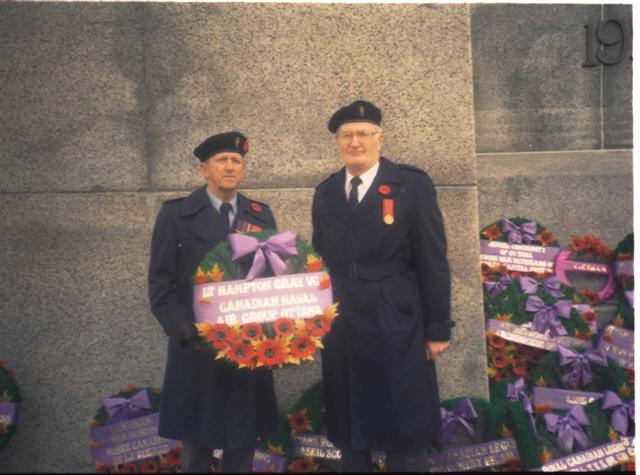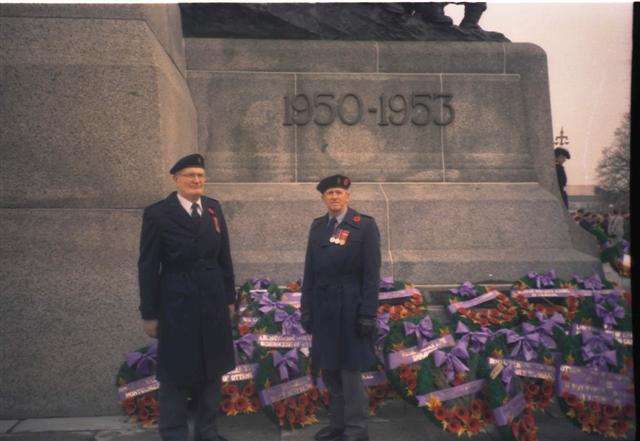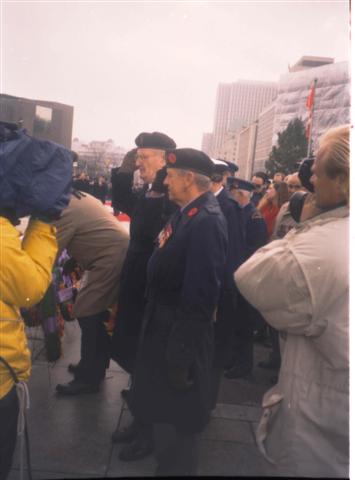My personal interests.

Memories of Remembrance Day 1993 — A Tribute.

It's starting to be a habit now, going to the National War Memorial to join the dwindling numbers of veterans in remembering the terror of wars past. Like most people attending the ceremonies, I wasn't there. I wasn't even alive when they happened. But through the television and press, the stories of the wars then and those which occur now, give a bit of the flavour of the battles.
The fear.
The dying.
The wounds –
physical and mental.
And the friendships.
Friendships true and strong. My Dad belongs to the
Canadian Naval Air Group (CNAG), Ottawa Branch. On behalf of the Group, he lays
a wreath each year at the Cenotaph. Last year, he was joined by Doug Bruce and
Stan Connor. But like many veterans, Doug died earlier this year. But we
remained a four-some because Stan's son Paul came along.
Dad picked me up around 10:00 and we drove to the National Arts Centre parking lot. We parked in a spot Stan liked to use. We were a bit late and the ceremonial band and Governor General's Footguards were already in place. This made it hard to get to the 'inner circle' where the wreath was to be picked up. There seemed to be an impenetrable ring of crowd control fences. And people everywhere.
I noticed a large group of secondary students pressed against the fences. They had cameras and were straining to see. They were well behaved. They seemed sincerely interested in events. Maybe it was the hope of seeing an important dignitary like the new Prime Minister, Jean Chrétien. I noticed them later in the day, still watching, quiet. An honour to their school (Bell High I learned later from a letter to the editor of the Citizen).
We finally had to travel to the Wellington Street access to the memorial, passing through the dignitaries' seating, past the Armed Forces Band, the OBE choir, until we finally reached the point where the wreaths were waiting.
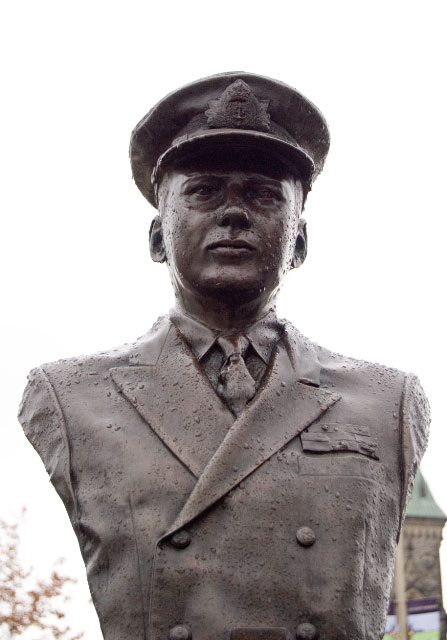
CNAG honours the memory of Lt. Hampton Grey, VC who died in an heroic effort to sink a Japanese warship. Dad said his plane carried two 500 pound bombs. One was shot off the plane before it could be used. The other found its mark as the wounded plane headed for its watery grave, taking the lieutenant with it.
The War Memorial looked very different this year. The
week before, Public Works completed a refurbishing of the brass figures of
soldiers, horses, cannon, rifles and all.
 It had been returned to its
original colours and coated with plastic to keep it from tarnishing. It was
heart-warming to see how many people looked on in admiration, pride, and
interest at the restored monument. It seemed to really hold some meaning for
them. The way it should. Many took pictures.
It had been returned to its
original colours and coated with plastic to keep it from tarnishing. It was
heart-warming to see how many people looked on in admiration, pride, and
interest at the restored monument. It seemed to really hold some meaning for
them. The way it should. Many took pictures.
Dad spotted the mayor of Ottawa, Jacquelin Holzman. I had sent her an enlargement of a slide I took last year of her, Dad, Stan and Doug. Dad went over to see if she had received it. She had, and invited Dad to bring his copy down so she could sign it with her gold pen. I wonder if Dad will do that. Probably not. But, you never know.
I watched the other important people milling about. The First Nations vets always fascinate me. Olvide Mercredi looked marvellous in his full headdress, buckskin coat and pants, and moccasins. There was John Manley, fresh from his re-election victory and a newly appointed cabinet minister. A few bars of the anthem are heard. The GG has arrived, with the PM.
The ceremonies proceed as the usually do. It is not so cold this year, it seems. But I am really dressed for the occasion, too. Just as the GG picks up this wreath to lay it at the memorial's base, as if on cue, the sun breaks through the cloud cover. I happen to turn to look behind me. All the workers on a construction project at Sparks and Queen have stopped their work and peer down from high up on their workplace. Stan recalls hearing of an incident in Halifax where workers stopped during the dedication of a memorial. They didn't have to, but they did. Nice touch.

Dad and Stan got their wreath laid near the beginning of the second wave (after the big wigs and some of the diplomats). They certainly take the job seriously. Dad likes to make sure the wreath is prominent so people can read the writing. Paul and I tried to take pictures but the TV crews got in the way.
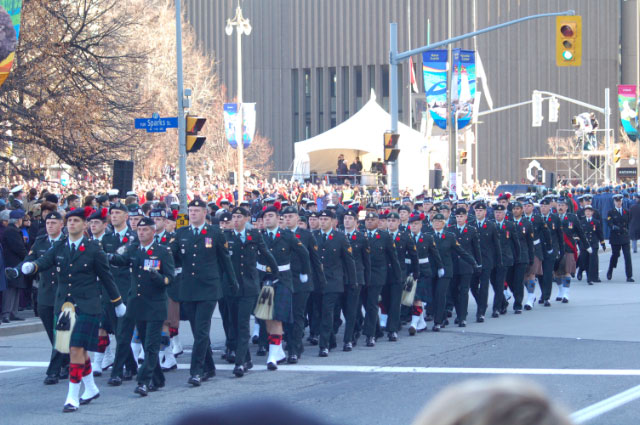 After the main part of the
ceremonies, we took up positions facing Wellington Street for the march-past.
It must be the military blood inside that really gets to me at this time. The
marching, the bands playing familiar marching tunes (like Hearts of Oak for the
Navy), the salutes. But it is the veterans marching by that gets the emotions
going strong. Tears always come to my eyes. I'm proud of these men and women
and what they did. I remember. I give thanks.
After the main part of the
ceremonies, we took up positions facing Wellington Street for the march-past.
It must be the military blood inside that really gets to me at this time. The
marching, the bands playing familiar marching tunes (like Hearts of Oak for the
Navy), the salutes. But it is the veterans marching by that gets the emotions
going strong. Tears always come to my eyes. I'm proud of these men and women
and what they did. I remember. I give thanks.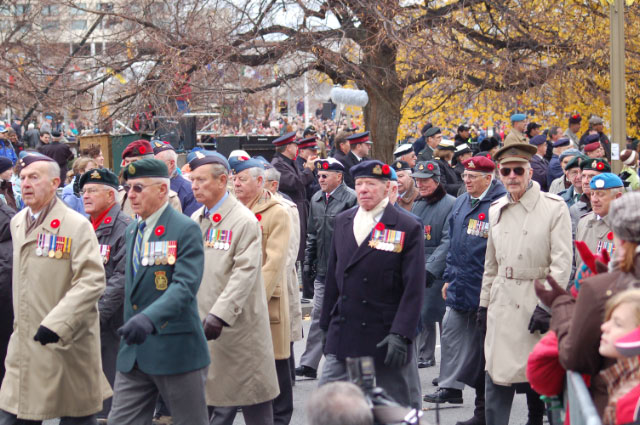
Stan points out a man with a scottish regiment hat. He tells us it is Ernest "Smokey" Smith, one of the two living Victoria Cross holders. Paul tries to get his picture, but he disappears into the crowd. After the parade, the crowd lining Wellington Street convinces Jean Chrétien to come near. He shakes and touches hands. One lady gives him a big hug.
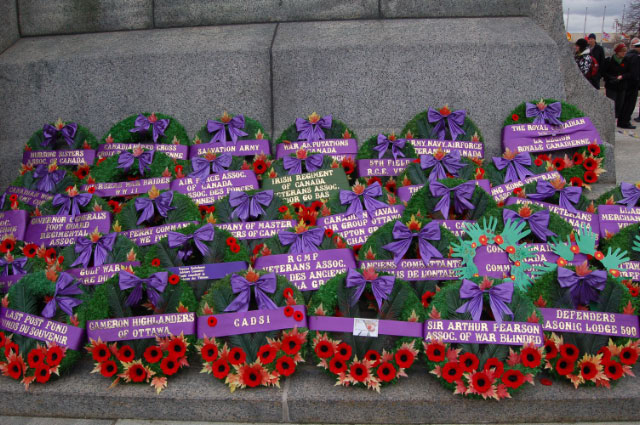 The crowds walking by the piles of wreaths
mounting the steps of the memorial are heavier than I remember from last year.
Paul and I want to get pictures of Stan and Dad with their wreath, but it is
difficult. While waiting a young lady strikes up a conversation with Dad. She
is keenly interested in the medals, stories, etc. I can't really figure out
why. Paul takes her picture and gets her address so he can send her a copy.
The crowds walking by the piles of wreaths
mounting the steps of the memorial are heavier than I remember from last year.
Paul and I want to get pictures of Stan and Dad with their wreath, but it is
difficult. While waiting a young lady strikes up a conversation with Dad. She
is keenly interested in the medals, stories, etc. I can't really figure out
why. Paul takes her picture and gets her address so he can send her a copy.
We get some pictures. Then we meet Russ Moses, a neighbour of Dad's and a navy veteran. He joins us for the walk back to the car and the trip to the Navy Club on Victoria Island. Names are dropped. Stories begin to be told. Do you remember....? I worry more about breathing as Paul, Russ and I are squeezed in like sardines in the back of the car. No seatbelts on as there is no room to find them.
The Navy Club. A huge picture of Halifax Harbour (Bedford Basin actually) taken in 1941 or '42 covers most of one of the thick, grey stone walls. A convoy is being formed. The water is covered with ships of every description. Other pictures are of frigates. I find out there are two classes, the difference being the design and placement of the fo'castle. There is a ship's wheel. There are navy uniforms everywhere. And the men in them look as if they just walked off a ship and slipped into a quay-side bar to relax.
The conversation starts with the recent CNAG convention in late October. Dad tells me about a fellow selling memorabilia - ships' crests, insignia, pins, badges, and such. He presents me with a CNAG Ottawa pin. I put it on. I really like it. A keepsake to cherish and remember this day.
We are joined by various men during our stay. Bill Calver is a real character. He passes around a card showing he is a member of the old bastards club. A Zwicker drops by. I tell Dad I remember a Fulton Zwicker. Other names come out - Admiral Landimore, ship's captains under whom Stan or Russ or Bill served. Some are familiar, some not.
The stories start to flow as the ale and rum relaxes the group. The clam chowder or spicy chili, with crackers and rolls, fills the empty stomachs. Paul comments about the bond of friendship which exists between these seamen. We may count our colleagues at work as friends, but they do not last as long as these navy friendships. There is something special about having lived, eaten, drunk, and swore with these fellow shipmates, often for months at a time at sea. More than friends, in wartime you depended on them for your life, and they likewise on you.
The stories are fun to hear. Most I have never heard before. Dad says some of them are recounted in the various books, like Banshees. I listen closely...
Dad got off ship one time when I was very small, picking up his ration of a 40 ouncer of rum. He and Mom were going out that night and asked Fulton Zwicker to babysit. No problem, says Fulton. Dad invites him to enjoy a drink while looking after me. They return to find him fast asleep, the empty bottle of rum nearby. Some babysitter! He stayed the night.
Dad's closest brush with death. Shearwater, doing maintenance on a Seafury. They use a gunpowder cartridge to kick over the engine. There is a holder for six cartridges on the engine. They use about ten without success. Dad goes to the engine to try to find out what was wrong. The other guy decides to try firing up the engine one more time. Dad hears the bang and the propeller begins to rotate. He hits the deck, the propeller within a fraction of his body. He sees a friend in the hangar entrance go pale. Frantically the friend signals the pilot to stop the engine. A close call.
Stan remembered Gibraltar as his closest call with accidental death. He was there with a helicopter squadron. There were six helicopters, parked nose to nose in a threesome, with their rotors folded. Standard procedure is to move them apart, unfold the rotors and turn them to face the wind. It didn't seem too windy, so they pulled them apart, unfolded the rotors but didn't turn three around to face the wind. Now, when helicopter blades rotate they change their pitch twice during a full rotation. As one of the 'copters not facing the wind started up, a gust of wind caught one of the blades and caused it to dip towards the ground. Right where Stan was standing. He said the blade passed within two inches of his face.
Stan and others talked about the frigates and their design. Some were not done right and they were too long. When the bow went up on a wave the stern would go under the previous wave. That is why they changed the length of the forecastle on the later models.
Stan has lots of tales about being on board the ships. Like the fact they used to roll so much, that on the bulkheads there were footprints way off the floor. It was where you planted your feet when the ship rolled on the sea. Sometimes there would be a big wave, it would hit the ship and dislodge the heavy chain from its resting place in the bunker. When asked to clear the mess, they often referred to playing a little golf on the links.
The funniest stories are about the heads. They were fun to use on a pitching ship. The water passes through from one side of the ship to the other, under the heads. Stan said if one were constipated, you just had to sit there as the ship pitched and the water rushed out, creating a suction effect. Of course, on the other part of the roll the water would rush in - and up.
And since the water went in one direction, they used to have fun with newspaper and matches. If you dropped the flaming paper in the first, or upstream, head, it would be carried along to those downstream. They figure that is where the term hot seat comes from!
The afternoon is progressing nicely, now after two. We are thinking about leaving. The power goes out. A funny thing since the Navy Club is directly across the street from an Ontario Hydro generating plant.
Dad drops me off at home. It has been fun. I feel the urge to write down my thoughts and feelings. I don't want to forget what I have experienced. I want it to be something I can share with others.
There, I've done it. Feels good. Thanks, Dad, for a wonderful day of memories.
Nineteen ninety-three. November 11. The eleventh hour. Remembrance Day. Memories of a time spent with my Dad.
Written
November 21, 1993. Published in the Warrior, newsletter magazine of the Shearwater Aviation Museum Foundation, Summer 2018, page 21.
Date of last revision: 2018-09-17.
Text and
photos © 2018 David Darwin
